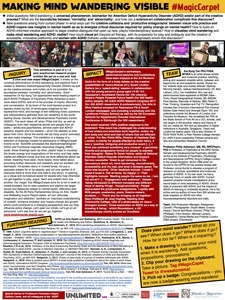Tan, Kai Syng 
Abstract
This poster was displayed at the Social, Genetic and Developmental Psychiatry Centre for 5 months, between October 2018- March 2019. It outlines the processes behind my 2-year project #MagicCarpet. The Social, Genetic and Developmental Psychiatry (SGDP) Centre is an interdisciplinary research centre that focuses on how genetics (‘nature’) and the environment (‘nurture’) interact to affect psychiatric disorders, neurodevelopmental conditions, and individual differences across development. Scientists at the SGDP lead some of the UK’s foremost longitudinal cohort and twin studies including TEDS, eRISK, Dunedin, IMAGEN and GLAD. Its initial questions were: Mind wandering: a universal phenomenon, biomarker for Attention Deficit Hyperactivity Disorder (ADHD) and/or part of the creative process? What are the boundaries between ‘normality’ and ‘abnormality’, and how can a science-art collaboration complicate this discourse? The new questions arising from current phase were: In what ways can the creative collisions and ‘productive antagonisms’ between visual arts practice and ADHD inspire new insights in mental health so as to energise critical discourse required for policy change on mental health? How to build an ADHD-informed creative approach to stage creative dialogues that open up new, playful interdisciplinary spaces? How to visualise mind wandering and make mind wandering and ADHD visible? How could visual art (beyond art therapy, with its propensity for play and ambiguity and the creation of accessible, innovative platforms) and women with ADHD (hitherto under-researched, under-diagnosed) enrich this discussion? We Sat On A Mat and Had a Chat and Made Maps #MagicCarpet was an award-winning art-science commission (2017-2019) that has already been enjoyed offline by 10,000 people worldwide. Psychiatrists, clinical psychologists, academics, service users, health policy officers, dyslexic children, teachers, art lovers and more aged 2-85 have enjoyed its tapestry art installation, workshops, films, keynote lectures, performances, photographs, badges, seminars and more at Southbank Centre, Science Museum, NESTA Innovation Showcase, Peter Scott Gallery (Lancaster) in the UK, SOS Dyslexia Conference in San Marino, covered Big Issue North and Resonance FM, and the cover of British Journal of Psychiatry, discussed in The Conversation, and described as 'beautiful' (Disability Arts Online) and having created a 'family' for neurodivergent people (The Psychologist). #MagicCarpet ed by Unlimited and supported by King's College London.
Repository staff only
 |
Edit record |


![[img]](https://e-space.mmu.ac.uk/624504/1.hassmallThumbnailVersion/2018Sept24_Academic%20poster_DrKaiSyngTan.jpg)